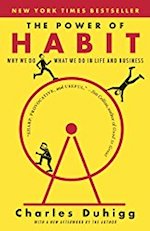The Power of Habit. Why We Do What We Do in Life and Business, by Charles Duhigg
Charles Duhigg is a Pulitzer-prize winning reporter for The New York Times. In The Power of Habit, the author proposes a framework for understanding the importance of habits and how habits work. Throughout the book, Duhigg uses stories —real stories— to exemplify his points, and he does a great job telling them. The stories are based, in part, on Duhigg’s interviews and journalistic research.
Perhaps the most important concept in the book is the Habit Loop, the loop that governs any habit. It is composed by three elements: cue, routine, and reward.
- The cue is what triggers1 the habit. It tells our brains to go into automatic mode and which habit to use.
- The routine is the action itself, which can be pyshical, mental, or emotional.
- The reward helps our brain figure out if the loop is worth remembering for the future.
Over time, this loop —cue, routine, reward— becomes more and more automatic. The cue and reward become interwined until a powerful sense of anticiaption and craving emerges. Eventually (…), a habit is born.
In presence of the cue, says Duhigg, the habit emerges. Our brain stops making decisions, and the pattern folds automattically.
[Habits] can emerge outside our consciousness, or can be deliberately designed. (…) They often occur without our permission, but can be reshaped by fiddling with their parts. They shape our lives far more than we realize —they are so strong, in fact, that they cause our brains to cling to them at the exclusion of all else, including common sense.
It is by learning to observe cues and rewards that we can change our habits or cultivate new ones.
Part One of the book is the best part of this book. Based on numerous researchs, the author explains how new habits are formed, and how old ones can be replaced for new behaviours.
Part Two of the book —habits of successful organizations— and Part Three —the habits of societies— are interesting, but in my opinion, the author relies too much in stories to sustain his points. Some of these stories are used to make unjustified generalizations in some cases, and oversimplifications in others.
- Other authors, like Marshall Goldsmith, refer to the cue as trigger. ↩
